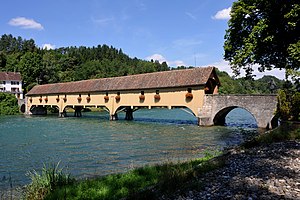Rhine bridge Rheinau-Altenburg
Coordinates: 47 ° 38 ′ 51 " N , 8 ° 36 ′ 11" E ; CH1903: 687488 / 278,087
| Rhine bridge Rheinau-Altenburg | ||
|---|---|---|
| View from the Swiss bank | ||
| use | Road bridge | |
| Crossing of | Rhine , km 57.0 | |
| place | Rheinau ZH , Altenburg | |
| Entertained by | Canton Zurich | |
| construction | Covered wooden bridge | |
| overall length | 80 m | |
| width | 4.3 m | |
| Longest span | 21 m | |
| Load capacity | 8 tons | |
| completion | 1806 | |
| location | ||
|
|
||
The Rhine bridge Rheinau-Altenburg is a road bridge that spans between Rheinau in the canton of Zurich and Altenburg , a district of Jestetten, the High Rhine and the border between Switzerland and Germany. The covered wooden bridge is designed for one lane and is one of the Pfahljoch bridges, which are rare today . It can be used by vehicles with a maximum weight of 8 tons.
history
The first evidence of a Rhine bridge near Rheinau comes from the year 1247. It is documented for the year 1324. The probably narrow, covered wooden bridge with four to five pile bays initially served the Rheinau monastery as a connection to its lands on the northern side of the Rhine and thus as a Connection of the Klettgau with the Thurgau . In 1444, in the course of the Old Zurich War , the building was badly damaged and was temporarily only usable for light traffic. In 1799, French troops broke off the Rhine bridge when they withdrew from southern Germany during the Second Coalition War . From 1804 to 1806, Blasius Balteschwiler erected the present building as a replacement on behalf of the Canton of Zurich for 6,600 guilders . Major repairs were carried out in 1885, which also included reinforcing the structure, and from 1918 to 1930 with work on the pile yokes. After heavy infestation of the wooden structure with house buck was found in 1953, heavily damaged components were replaced and in 1954 the structure was further reinforced. From 1924 the use of the bridge was restricted to vehicles with a maximum mass of 5 tons, in 1953 it was reduced to 2.5 tons and since 1988 it has been limited to 8 tons.
In 1988, extensive repair work was carried out on the construction for 2 million francs. The pile yokes were replaced in the substructure. Since then, wood-clad steel yokes have stood on 1.5 to 2.0 meter high reinforced concrete foundation beams . Among other things, the cross members of the superstructure were reinforced with steel elements and individual struts that were too weak were replaced.
A bronze sculpture of the patron saint, Saint Nepomuk , by Emilio Stanzani is placed on the pillar pulpit of the fore bridge on the Swiss side . It replaces a sandstone statue that stood there until 1872.
construction
The approximately 80-meter-long structure consists of a three-span, approximately 63-meter-long covered wooden bridge and stone bridges on both sides as abutments. The brick, uncovered arch bridges have two openings on the right and left bank of the Rhine. The wooden bridge is 4.3 meters wide and 3.05 meters high and has three fields with spans of around 21 meters. The main supporting structure in the longitudinal direction consists of a triple truss . The carriageway rests on longitudinal girders, which transfer the loads into the truss via cross girders and hanging columns. The load-bearing capacity of the wooden structure was increased by installing nine high-hanging steel longitudinal members and four steel frames. The two middle bridge piers are designed as pile yokes, each consisting of a row of eight piles.
See also
literature
- Hans Rudolf Stierli, Erwin Stucki, Paul Wüst: Before the construction of the N4: the Rhine crossings between Stein am Rhein and Eglisau. In: Rhine bridge N4. Edited by the National Road Office of the Canton of Schaffhausen, Meier Verlag Schaffhausen 1995, ISBN 3-85801-112-6
Web links
- IVS Documentation, ZH 902.1.2, Rheinauer Rheinbrücke (PDF file; 254 kB)
|
The next bridge upstream: Bridge to the Rhine island with the Rheinau monastery near Rheinau (does not span the whole river) Bridge over the Rheinau power plant |
Bridges over the Rhine |
The next bridge downstream: Rheinbrücke Rüdlingen |


